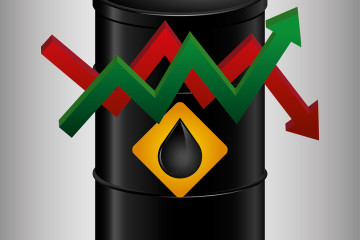Oil Investors Just Aren’t Buying the Price Rebound Story: Gadfly

(Bloomberg Gadfly) —The most striking aspect of the energy sector in recent weeks has been an all-round lack of confidence.
Relative to the wider market, the E&P sector’s performance this month looks even worse given that the S&P 500 is essentially flat.
Clearly, crude oil hovering around $50 a barrel doesn’t represent a return to the good old days.
Oil Price That Doesn’t Represent A Return To Good Old Days
$50
Equally, though, it isn’t at the disastrous levels of a year ago. The futures “strip” — the average price for the next 12 months — has recovered from the sell-off in March and trades around the same level it jumped to in the aftermath of the OPEC supply-cut announcement at the end of November.
Moreover, many E&P companies have already taken the opportunity to lock in prices at around that level via hedges, according to data from Bloomberg Intelligence, providing some protection against any weaker prices ahead. Meanwhile, rig counts, payrolls and services providers such as Halliburton Co. are sending strong signals of a rebound in U.S. onshore drilling.
When earnings season for E&P firms kicks off next week, the messaging, at least, will be pretty bullish in terms of growth plans (and that is what tends to count in this sector). Questions about cost inflation, the shadow hanging over the industry for the past year, will likely be less urgent than on prior calls, given that oilfield-services stocks are down almost as much as their E&P counterparts. So why so glum?
The likeliest culprits are oil and gas prices. The latter, which tends to be forgotten, accounts for roughly half the output of U.S. E&P firms, so it matters. Lingering wintry weather in the northeastern U.S. has helped rally gas prices from their plunge in February, which resulted from the opposite weather pattern that month. Yet E&P stocks weighted to the fuel haven’t responded:
This makes sense, because extra supply from places like the Permian basin and, especially, the Marcellus shale look set to kill any rally as the year progresses.
When it comes to oil, things are more nuanced. At $50 a barrel, the sector can certainly drill more wells, but at a corporate level — factoring in overheads, interest costs, and other unhelpful line items — bottom lines look set to stay razor-thin at best. When OPEC announced its supply-cut plan in November, bumping oil prices up, E&P stocks went up with them, as $50 suddenly appeared to be just a staging post on the way to even higher prices. A month before the OPEC announcement, oil futures for 2017 averaged less than $50; a month later they were above $56.
Since then, two things have happened.
First, faith in OPEC’s ability to juice prices in the near term has been shaken as data on inventories have been mixed. Wednesday’s update from the Energy Information Administration offered the latest example, showing a small drop in U.S. crude oil inventories but an increase in stocks of gasoline (oil was almost a buck lower following the report as I wrote this).
Second, enthusiasm for E&P stocks raced ahead of the oil price. Companies involved in the red-hot Permian shale basin rose especially quickly, with a concomitant surge in M&A activity in the region adding to the sense exuberance was getting out of hand. Only a month ago, analysts at Sanford C. Bernstein published a survey showing sector valuations, especially for Permian-focused stocks, were well above historic averages on all major multiples.
So the recent drop looks like a combination of inflated enthusiasm for sector earnings colliding with fatigue around the oil-price recovery.
With the narrative of cost-efficiency and growth plans now widely disseminated, it is going to take an external catalyst to tempt significant money back to the sector — namely, a clearer path to $60 oil. This month’s earnings calls won’t offer that. Look ahead a month, though, and OPEC’s own meeting just might.
This column does not necessarily reflect the opinion of Bloomberg LP and its owners.
Liam Denning is a Bloomberg Gadfly columnist covering energy, mining and commodities. He previously was the editor of the Wall Street Journal’s “Heard on the Street” column. Before that, he wrote for the Financial Times’ Lex column. He has also worked as an investment banker and consultant.







No Comment